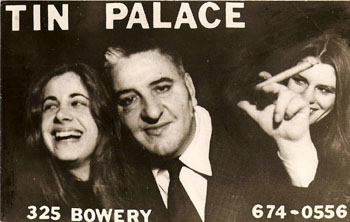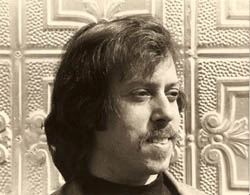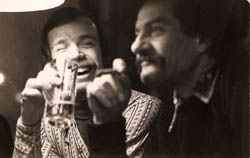THE TIN PALACE

Early ad for Tin Palace, located at the northeast corner at East Second Street
The ad depicts two TP waitresses, Royalin Ward and Leslie Jacobson with an early regular, Kelly Fabrizio.
Royalin was an abstract painter, partner of Charles Hewitt, a rowdy expressionist of some notariety.
By Andy Schwartz
(October 2008)
INTRO: In 1975, at 315 Bowery, Hilly Kristal was opening up C.B.G.B. to the advance guard of New York rock: Television, Ramones, Blondie, and the rest. But just up the street, Brooklyn native Paul Pines had been running a successful jazz club called The Tin Palace for five years, offering much-needed exposure to American artists ranging from bop vocalist Eddie Jefferson to AACM stalwarts Roscoe Mitchell and Kalaparusha Maurice McIntyre. An aspiring writer and poet as well as a jazz fan, Pines traveled to San Francisco to meet the Beats, then returned to New York to take up residence in the East Village.Paul Pines: In 1960, I came back from San Francisco and was without a place to live. So I found an apartment on East Ninth Street between Avenue B and C. It was a sixth-floor walkup at $30 per month, which I shared it with two other guys, $10 each.
The immediate neighborhood was deep White Russian—this was before the Ukrainians came. I lived on a 25-cent-a-day bowl of soup and two pieces of bread from a Polish place. The life of the poet! But I was at an age when it was an adventure. We made it.
The old Stanley's, on 12th Street and Avenue B, became a hip place where Harlem met bohemia. H. Rap Brown drank there, Leroi Jones ran around there, and a lot of white painters and writers drank at Stanley's. The Annex opened at 10th and B, and The Old Reliable was a theater bar on East Third Street. A kind of saloon circuit began to emerge, and then [circa 1962] Slug's opened on East Third between B and C.
It was the jazz place for years, the only one in the East Village, and eventually I began to get to know the local musicians. Howard Johnson lived across the hall from me. Morgan Freeman was in the next building. Kenny Dorham, Frank Morgan, Hank Mobley—if they didn't live in the neighborhood, then they played Slug's all the time. Slug's became my real musical education.
Pines joined the Merchant Marine and sailed the world from 1964-66. Upon his return, he moved into a wood and tarpaper shack, six flights up on the roof of 57 Second Avenue between Third and Fourth Streets. It remained his home for many years. After a brief stint as a film publicist for United Artists, Paul took the first in a series of bartending jobs downtown.
Pines: When I returned to New York, the world had absolutely changed. In jazz, there was Ornette Coleman and Don Cherry, Monk and Mingus and Coltrane. A guy in my building designed album covers for ESP-Disk, and through him I got to know the music of people like Albert Ayler.
The avant-garde players came up with a different mindset, a sense of networking. They wrote grants, created venues, promoted their own shows. With Lyndon Johnson's "Great Society," there was more money around for this kind of creativity. Few people today could imagine Albert Ayler getting a government grant to do anything, but he did.
In 1969, Paul was managing a Bowery bar called Phoebe's when two East Village real estate entrepreneurs, Misha Saradorff and Charlie Burke, approached him with the idea of backing Pines to open his own place. With Mike Spira as his working partner and Saradorff and Burke in the background, Paul Pines opened the Tin Palace in 1970.
Pines: The legend was that the place had been a speakeasy run by (mob figure) Meyer Lansky. When we excavated the basement, I found in the rubble a copy of the New York Post announcing the end of Prohibition. It had deteriorated from a working-class bar to a real bum's bar, abandoned and full of trash. That whole corner was like a no man's land.
We took everything down to the brick. We re-supported the building with steel. We built offices downstairs, our own booths, our own tables—I'd learned how to set up a kitchen. We worked for about five or six months. There was a piece of sculpture out front by Bobby Bowles, a third-tier Abstract Expressionist. He bolted the steel into the sidewalk in front of the bar.

Pines: "This photo of me by the tin wall was taken just after the opening by Karen Drexler Marks.
We used ceiling tin onthe exterior wall to cover up a fissure in the building. Hence the somewhat ironic name of the place."
The Tin Palace was pitched to the artists in SoHo. Everyone who worked in the place had their own following, including myself. So by the time we opened, everybody from Max's Kansas City, from St. Adrian's, from Phoebe's, they all came to check out this new thing.
"Big Charlie" was a bartender from the old Stanley's who played saxophone and had an encyclopedic knowledge of jazz. He put together the Murray Shapinsky Quartet—it was named for some unsung Jewish jazzman that Charlie loved—and we started having live music by the end of the first year.
Some months later, a flute player named Lloyd McNeil asked me if he could play at the place. I'd heard him with the guitarist Allan Gittler, who'd built his own kind of space-age guitars—there's one in the Smithsonian. Lloyd and Allan played duos for a while, then Lloyd asked if he could bring in a larger group. They were all Brazilians: [guitarist] Amaury Tristao, [pianist] Dom Salvador, some really fine players. People began to flock to hear the Brazilians.
The groups would play three or four nights per week for months at a time, as the house band—I loved the idea of having a house band. It built a wonderful following, and The Tin Palace began to get noticed. We built a real stage, and then an outdoor café on one side of the building. It was a very diverse crowd from the start, as many black patrons as white.
At first, there was just a minimum charge at the table, no cover. My vision was to build up a grass-roots place, not to make a killing off the door.
I'd watched Slug's turned into a drug-plagued hellhole, where a trip to the men's room was like a descent into Hades. I learned from that. I said, at the Tin Palace, we'll have music as good as Slug's but in an environment that's safe, so people can come in and really listen to the music.
One of the rules I made, ironclad, was no drugs in the house. Whatever you wanted to do out in the street was cool. But anybody caught doing anything in the bathrooms would be barred from the club. That doesn't mean some things didn't go on after hours, downstairs--but during business hours, no. It's one reason why I stayed open so long.

Pines: "photo of Aldo and Rodeo Jim: two of the bartenders that worked my room.
Both were popular with ladies but especially Rodeo Jim. Women would nightly slip him their phone numbers of folded napkins."
[Saxophonist/flutist] Jimmy Giuffre brought in a trio to play these wonderful, almost baroque jazz pieces. The music was very intellectual, almost liturgical. Nobody knew quite how to react to it except the people who worked at the place, for whom it became a kind of cause célèbre. The waitresses, the bartenders—they all loved the music and the musicians.
[Vocalist] Eddie Jefferson made his comeback at the Tin Palace—he'd been out of the music business. But Eddie and [saxophonist] Ritchie Cole became an inseparable partnership and held forth at the club for months, with enormous energy.
Meanwhile, over on Bond Street, there was the Ladies' Fort run by [vocalist] Joe Lee Wilson [opened 1973]. [Saxophonist/flutist] Sam Rivers opened his loft, Studio Rivbea [in 1970]. Stanley Crouch and [saxophonist] David Murray moved to New York [from California, in 1975], and they began doing performances in the loft upstairs from my club [home of the artist Francis Hines].
One day, Stanley and I--along with Harry Lewis, who worked behind the bar and was savvy about the scene--we came up with this idea of an avant-garde series. We had people that no one else was hiring at the time. No one was hiring David Murray or James "Blood" Ulmer or Sunny Murray or Henry Threadgill.
But Harry and Stanley would book them, and I hung out, I heard, I learned. There were certain places I couldn't go--for instance, I couldn't hear Cecil Taylor. But I went a lot more places than I would've thought I could. And we went on with these two kind of musical momentums: the avant-garde series on Sundays, and the more straight-head music the rest of the week.
Live at the Tin Palace – May 1976 [highlights]
(7-8 and 14-15) Roswell Rudd + Sheila Jordan
By the mid-Seventies, Roswell Rudd--trombonist, composer, and stalwart of the Sixties jazz avant-garde--was gigging mainly with show bands on the Catskill resort circuit. Here he teamed with singer Sheila Jordan, who moved from her native Detroit to New York in 1951. Both artists are still active in 2008.(11-13) Rene McLean [a/k/a Muhammad Al-Amien Abdul Kariem]
The son of famed altoist Jackie McLean (1932-2006), he co-led the group Cosmic Brotherhood with his father in the early Seventies and later recorded solo albums such as In African Eyes (1994).(21-23) Cecil McBee Sextet
McBee, who backed Dinah Washington in 1959 and Wayne Shorter in 1970, remains among the most in-demand bassists in jazz. In 2005, he lost a protracted lawsuit in which he sought to prevent a "Cecil McBee" chain of clothing boutiques in Japan from using his name without compensation.(25-27) Jeanne Lee
"The most innovative singer to have emerged from the new music of the 1960s" (The New Grove Encyclopedia of Jazz), Jeanne Lee performed and recorded with such collaborators as Ran Blake, Gunter Hampel, and Archie Shepp. She died of colon cancer in 2000.(30) Roscoe Mitchell with Philip Wilson
A founding member of the Art Ensemble of Chicago, Roscoe Mitchell continues to teach, perform, and record. Former Art Ensemble drummer Philip Wilson joined the Paul Butterfield Blues Band in 1967, and later worked with David Murray, Lester Bowie, and his own funk-rock-jazz group Deadline. He was murdered in the East Village in 1992.
Pines: Only one album was ever released from the club [Battle of the Saxes: Live at the Tin Palace by Eric Kloss and Ritchie Cole, 1977]. But nobody made any records at Slug's either. These clubs were different from the Vanguard or the Village Gate. These were really underground alternative clubs, and they had a certain anonymity to them. They generated an awful lot of energy, because they were great venues, but they didn't become commercial products.
In the course of things, it was clear to me that the recession was taking its toll and we weren't going to survive. The music costs were too high and the revenues were too low.
Jack Sherlock owned The Surf Maid on Bleecker Street. Jack used to come in all the time—he loved the room—and eventually he bought the Tin Palace in late 1977 or early '78.
I walked away. I said, that's enough—I've done what I needed to do. The place continued for another two or three years. Jack kept Stanley Crouch on and Stanley booked it with more big names, but not that much more than we'd had.
I've booked the Lake George Jazz Festival [in upstate New York] for 23 years, and I still work with a lot of musicians that I knew from those days at the Tin Palace. I have a deep and abiding love of that time.
In 1983, Paul Pines' first novel The Tin Angel was published by William Morrow. The story is set in the East Village, and its protagonist is a Jewish jazz club owner who becomes embroiled in a drug-related murder case. He has published five books of poetry including Adrift on Blinding Light (IKON, 2003). Paul Pines lives in Glens Falls, New York, where he teaches at Adirondack Community College and practices as a psychotherapist. On August 1, 1995, the Jazz Gallery opened at 290 Hudson Street with a commemoration of the Tin Palace legacy, featuring music by Lloyd McNeil and Arthur Blythe.

Recent picture of Pines and percussionist Bobby Sanabria
Postscript: Paul Pines adds "(I'm working with) my collaborator, Dan Asia, the composer who has been setting my poems for the last thirty years--which appear on two CD's on the Summit label. We are now working on an opera based on a libretto I wrote taken from (my book) The Tin Angel." Also see Pines' website.
